At first glance, crickets and grasshoppers may appear very similar. For someone whose eyes aren’t trained, it would be difficult to tell these insects apart.
Are crickets and grasshoppers related in any way? Both of these insects belong to the same order Orthoptera. However, they belong to different suborders. Crickets belong to the suborder Ensifera, whereas grasshoppers belong to the suborder Caelifera.
Although crickets and grasshoppers look like the same insect, several traits would distinguish one from the other. This article will examine the distinguishing features to aid in identifying whether an insect is a grasshopper or a cricket.
What’s the Difference Between Grasshoppers and Crickets?
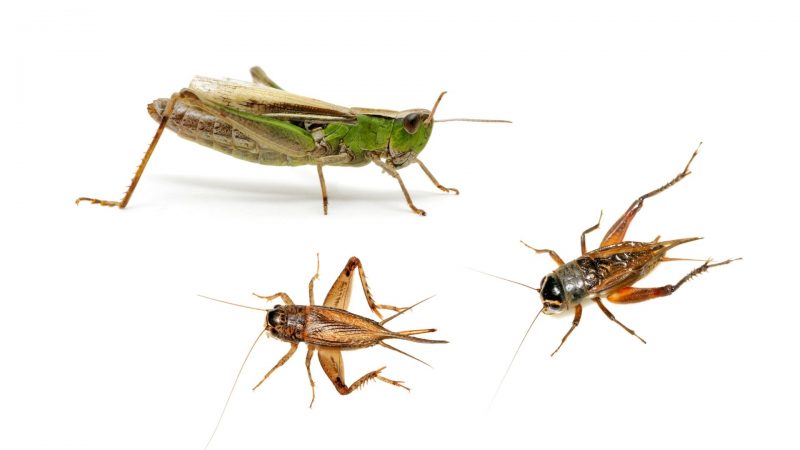
Crickets belong to the suborder of Ensifera, while grasshoppers are to the Caelifera. But both leaping insects belong to the order of Orthoptera.
Learning the difference between grasshoppers and crickets would also require knowing their similarities in order to get familiarized with their appearance and behavior.
Cricket and Grasshopper Distinct Similarities
Body Regions
As with all insects, the body of crickets and grasshoppers is divided into three sections: head, thorax, and abdomen.
The head carries two compound eyes, a pair of antennae, and their mouthparts. Attached to their thorax are the structures that provide locomotion, such as the legs and wings. The abdomen contains organs for digestion and reproduction.
Hind Legs
Grasshoppers and crickets have six legs attached to their thorax; and enlarged hind legs. These legs enable them to leap rapidly, especially when they are about to escape an enemy. Moreover, their hind legs have rows of spines, which provides them with a better grip on the surface while hopping.
Life Cycle
Grasshoppers and crickets both hatch from eggs and undergo molting several times prior to reaching the adult form. Each molting allows them to produce a larger covering as their body parts develop. Grasshoppers and crickets will develop wings and reproductive structures in their last molting.
Cricket and Grasshopper Distinct Differences
Antennae
The antennae of grasshoppers are short, usually less than half the length of their bodies. On the other hand, the antennae of crickets are relatively long, almost always exceeding their body’s length.
Feeding Time
The grasshoppers are diurnal, mostly active during the day, but their activity diminishes during cloudy weather. Crickets, on the other hand, are nocturnal. Crickets will feed at night and will take refuge in warm, dark areas during the day.
Singing Method
Crickets sing by means of stridulation or rubbing two parts of their body against each other. The sound is produced as the row of teeth (scraper) on the wings’ bottom edge rub against the file-like structure on the other.
Male crickets sing to attract female crickets. However, when they come in contact with another male cricket, they typically produce a different song, which entomologists refer to as a “fight song.”
On the other hand, grasshoppers produce sound in three different ways:
- Stridulation involves rubbing their hind legs against their front wings. The row of teeth on their legs is rubbed against the ridge on its wings to produce the sound.
- Crepitation is done by band-winged grasshoppers. This involves rubbing their wings together while flying. This method of singing is commonly accompanied by wing flashing, which is a dramatic visual display of their colorful hind wings.
- Drumming involves shaking or striking the hind legs against a substrate to produce sound.
Sound Perception
Grasshoppers perceive airborne sounds through the eardrum-like structure (tympana) located on their first abdominal segment. In crickets, the tympana are located on their front legs near the base of their tibiae.
Food Preference
Grasshoppers are primarily herbivorous or plant-feeders, while crickets are omnivorous/scavengers.
Other than plant foliage, crickets would also feed on other insects (living or dead) as well as decaying organic matter. As such, crickets could typically be seen in a wide range of habitats, even in areas with little vegetation, whereas grasshoppers are mostly found in areas and consume low-growing grasses or plants, including leaves, flowers, plant stems, and seeds.
Ovipositor
Grasshoppers have pointed but curved ovipositors that open upward and downward. Crickets, on the other hand, have long, compound tube-like ovipositors.
The ovipositor is used to make holes in the soil or into vegetation in preparation for egg-laying.
Egg-laying
Grasshoppers usually deposit their eggs in the soil, while crickets tend to deposit their eggs either in moist soil, sand, or plant tissues.
Mating
Female crickets will mount male crickets after courting. On the other hand, smaller male grasshoppers mount the female grasshoppers during copulation.
Jumping Distance
Crickets and grasshoppers are both capable of making long jumps. Considering how tiny they are, this is very astounding. A grasshopper can jump 2.6 feet, compared to the 3 feet of a cricket.
Species
In terms of species, grasshoppers exceed crickets by a large margin. Grasshoppers come in more than 11,000 different species. According to scientists, there are still a ton of undiscovered varieties of grasshoppers in the world.
On the other hand, there are more than 2,400 different species of crickets. With the exception of Antarctica, both of these insects are present worldwide.
Activity Period
At various periods, these two insects are active. During the day, grasshoppers can be observed hopping and scurrying about outside. They are on the prowl in search of blooms and stems to consume.
In the daytime, crickets doze off, while at night, they are busy. Therefore, if you hear chirping in your room or house at night, it’s probably a cricket!
Distinguishing Features
| Cricket | Grasshopper | |
| Size | The length of adult crickets varies depending on the species. Some of the commonly encountered crickets are the following: Field Cricket: 0.5 – 1.3” (13-34 mm) Bush Cricket: 0.35 – 0.55” (9 – 14 mm); 0.59 – 0.79” (15 – 20 mm) Tree Cricket: 0.59 – 0.71” (15 – 18 mm); 0.67 – 0.87” (17 – 22 mm); 0.39 – 0.55” (10 – 14 mm) | The most common grasshoppers belong to the Acrididae Family. Adult length: 0.39 to 2.76” (1 – 7 cm), depending on species. |
| Eggs | On average, female crickets lay around 270 eggs. | Female grasshoppers deposit eggs in clusters. Each cluster may contain 20 to 100 eggs. |
| Color | Crickets are typically dark-colored (brown or black). | Grasshoppers are often light-colored. Male grasshoppers are more colorful than females. Grasshoppers appear in a combination of green, brown, gray, and yellow colors. |
| Potential Pest | Crickets are less likely to cause heavy damage to vegetation but could be a nuisance when they occur in huge numbers. Tree and bush crickets also damage fruit trees as the female crickets excavate holes into the woody stems to lay their eggs. Indoors, crickets would feed on a variety of fabrics (cotton, linen, wool, rayon, nylon, silk, and fur), foods (fruits and vegetables), and paper products (wallpaper). | Grasshoppers are considered a major agricultural pest as they cause severe damage to wheat, alfalfa, soybeans, and corn plantations. Immature grasshoppers (nymphs) cause a great deal of damage to plants as they feed heavily on plant tissues and stems of newly emerged seedlings. Severe damage often causes the plant to die. During periods of high population, adult grasshoppers would feed on any plant, tree, or shrub, causing significant defoliation. |
Do Grasshoppers Eat Crickets?
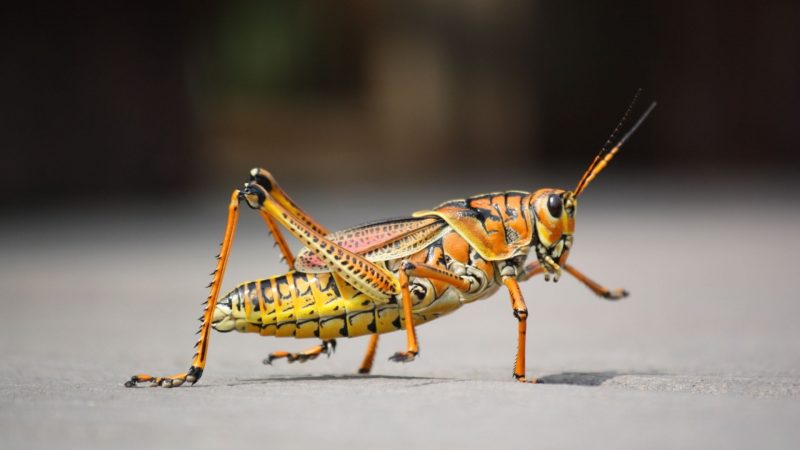
Grasshoppers do not prey on other insects. As herbivores, the diet of grasshoppers in the field mainly consists of plants and grasses.
Do Crickets Eat Grasshoppers?
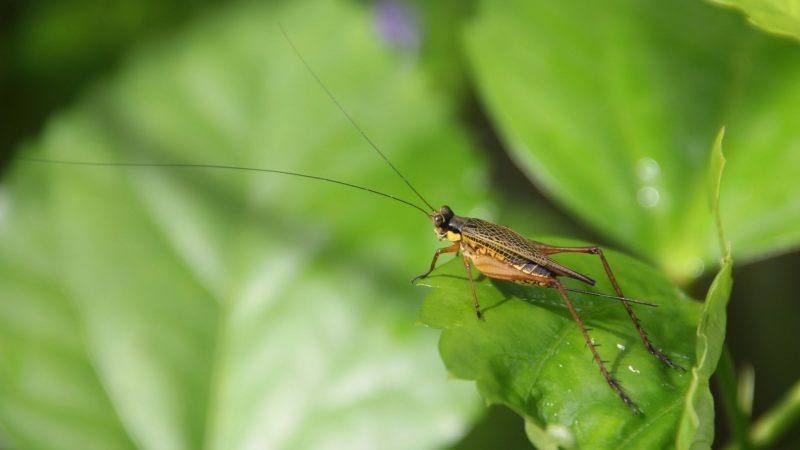
Crickets prey on other insects, including grasshoppers or eggs of grasshoppers. Especially when the food source is scarce, crickets can be opportunistic and cannibalistic. They would feed on living and dead insects, including other adult crickets, nymphs, or molting crickets.
Do Crickets and Grasshoppers Fly?
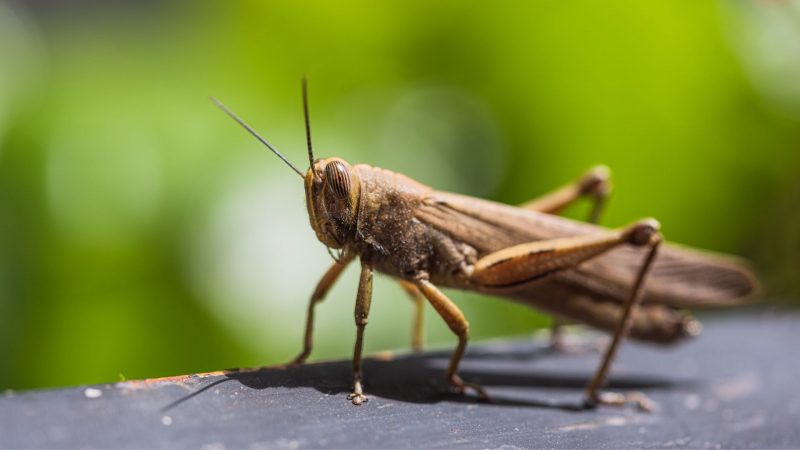
All grasshoppers are capable of flying, while some crickets are not.
Although all crickets develop wings as they reach their adult stage, not all of them can fly. For instance, some female field crickets are not capable of flying. However, this lack of flight ability is compensated by other features, as non-flying female field crickets are found to be more fertile. Meanwhile, some mole crickets are capable of flying long distances.
On the other hand, all grasshoppers are capable of flight. However, short-winged species are not capable of flying long distances compared to long-winged grasshoppers.
How to Get Rid of Crickets?
Outdoors
- Although crickets are often found outdoors, they may find their way inside the house through cracks and openings. Inspect any openings that could serve as potential entry points. Repair broken and damaged window screens and caulk cracks and crevices around your homes.
- Crickets are attracted to moist areas. Make your areas uninviting by removing dense vegetation and by cutting weeds and tall grasses.
- Bright lights attract crickets. Reduce the use of outdoor lighting to avoid attracting crickets in your area.
- The use of insecticides should be considered the last resort and should only be done during an extensive infestation.
Indoors
- Manual eliminating may be effective. However, the challenge lies in locating crickets, as they often hide in dark areas. Crickets may be eliminated using a fly swatter, a vacuum cleaner, or a brush and a pan. When eliminated, crickets should be disposed of off immediately to prevent other insects from preying on them.
- Baits may be used in areas where crickets may be hiding.
- Indoor insecticides may also be used in cracks and crevices. Caution should be observed when using insecticides as they contain toxic chemicals.
How to Get Rid of Grasshoppers?
Mechanical Control
In the field, controlling grasshoppers is best done by preventing access to potential egg deposit sites. Eliminating these sites involves tilling the soil, which not only deprives them of breeding sites but also exposes their eggs to potential predators.
However, since this method might reduce soil moisture that affects plants, it must be carefully assessed whether the number of grasshoppers can no longer be tolerated.
An alternative method of protecting valuable plants is by installing netting, floating row covers, or similar materials to prevent grasshoppers from entering. However, this method is only suitable for small gardens.
- Long Lasting - Traps crickets for weeks at a time
- Easy to Use - Simply fold the trap and insert the tab at the top...
- Discreet - Slides easily under furniture and bedding
- Versatile - For residential and commercial use
- 2 Traps - Two large traps included in each package
Cultural Control
Adult grasshoppers and nymphs feed heavily on low-growing vegetation. Thus, to reduce their number, it is essential to keep the crops free of weeds. It will also make the field unattractive to grasshoppers since there wouldn’t be any food source once the eggs hatched.
Monitoring Populations
Farmers should monitor populations of grasshoppers, especially the nymphs, to prevent future infestation. Detecting their presence early on would entail less use of insecticides when control is necessary.
Chemical Control
If control is necessary, careful selection of insecticide is essential. Insecticides are highly effective in controlling the population of grasshoppers. These chemicals work best, especially when the grasshoppers are still small (nymphs), as they tend to be clustered in certain areas but are less effective when they become adults due to their high mobility.
The use of baits and border treatments is commonly done to keep the grasshoppers’ population in check. When using this method, inspection of potential breeding sites is also necessary to ensure proper placement. The most widely used bait for grasshoppers is the carbaryl impregnated on wheat bran.
No products found.
If adult populations are infesting your field, reapplication of insecticide is necessary. Make sure to follow label instructions to determine the frequency of application and choose insecticides that are suitable for the field crops.
Does Bug Spray Eliminate Crickets and Grasshoppers?
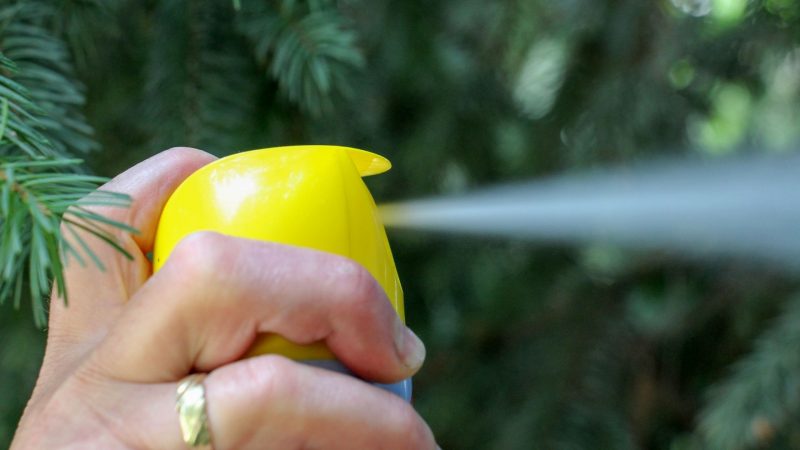
Bug sprays may also be used to eliminate crickets. Sprays are desirable and preferred as they provide access to hard-to-reach areas such as cracks and crevices where crickets are probably hiding.
Neem products are widely used to control grasshoppers. These products act as feeding deterrents, which reduce damage caused by foraging grasshoppers. Moreover, targeting nymphs with neem products may also be done. When applied to nymphs, it disrupts natural growth and eventually results in the death of immature grasshoppers.
Neem products are chemicals; however, people view these as natural control since they are essentially derived from plants, and therefore somewhat natural.
- LASTS THE ENTIRE SEASON - Just 1 bottle of our premium...
- STRONGER THAN NEEM OIL ALONE - Multiple active ingredients...
- FIELD TESTED & FARMER APPROVED - Our premium formulation has been...
- WORKS AGAINST 200+ PESTS & FUNGAL DISEASES - Controls Aphids,...
- FOR ORGANIC GARDENING - Natural alternative to conventional...
How to Make Homemade Grasshopper and Cricket Traps?
Sticky traps and water bottle traps are often used to catch grasshoppers and crickets. Although they are not as effective as other methods, these traps provide an estimate of the abundance of the insects infesting your areas.
DIY Sticky Trap
Step 1: Grab a piece of cardboard and cut it into medium sizes, usually five by seven inches. Cut as many pieces as needed depending on the number of placement locations.
Step 2: The cardboard wrapped with duct tape may be placed on a newspaper to prevent the tape from sticking to the floor.
Step 3: Place the traps in dark areas where crickets may be hiding, such as underneath refrigerators, furniture or bookshelves, and other dark areas around the house.
Step 4: Bread crumbs may be used as bait to draw the attention of crickets.
Step 5: Monitor the traps regularly and dispose of the crickets to prevent other insects from feeding on them.
Using Leftover Water Bottles
Step 1: Gather used or leftover water bottles, preferably 1 or 2-liter bottles, to allow more grasshoppers or crickets to fit in.
Step 2: Cut the top portion of the bottle.
Step 3: For grasshoppers, leaf or grass cuttings may be placed inside the bottle to act as bait. As for crickets, bread crumbs or sugar may be used for the same purpose.
Step 4: Invert the cut portion and place it back into the rest of the bottle.
Step 5: Secure the parts together with a little tape.
Step 6: Place the bottle on its side near places where crickets and grasshoppers may be found.
Step 7: Check your traps and dispose of crickets and grasshoppers that have been caught.
Here is a video about how to make a cricket trap:
How to Keep Grasshoppers and Crickets Away?
You might wish to prevent grasshoppers from loitering about among your plants because they do graze on it. Because crickets are drawn to light and can readily go inside, they may also be a pest that you want to keep off your outdoor area.
Planting flowers that will draw birds that prey on crickets and grasshoppers is one strategy to keep pests off your home. To attract grasshoppers and crickets to one area of your yard, consider planting a tiny patch of long grass. You might be able to keep these pests under control by drawing them to a specific region of your lawn.
To help you get rid of them on your own, consider the following further advice:
- Utilize organic repellents. Because grasshoppers don’t like the way it tastes or aroma of crushed garlic, you can repel them by making a simple discouraging spray by combining it with little water.
- Use all-purpose flour to dust plants. The barrier that flour forms prevents grasshoppers from easily accessing your grass while not harming your plants.
- Bring a few helpful insects. Crickets and grasshoppers are all preyed upon by spiders, mantises that hunt their prey, beetles, and even lizards. Consider luring these helpful species nearby before applying insecticide.
- Take out the neon lights. Since crickets are drawn to bright lights, having a well-lit entrance could be luring them to your house. Think about converting to amber LED lights or lower bugs lights.
- Trim the grass frequently. Make sure your lawn is kept up regularly to deter them from constructing their nests.
List of Sources
Gray, D. (1997). Female House Crickets, Acheta Domesticus, Prefer the Chirps of Large Males. California State University, Northridge.
Grasshoppers. University of Michigan.
Hein, G., Campbell, J. (2008). A Guide to Grasshopper Control in Cropland. University of Nebraska – Lincoln.
House-Invading Crickets. University of Missouri.
Patrick, C., Davis, S. (2004). Grasshoppers and Their Control. Texas AgriLife Extension.
- Bed Bug Surge 2025: How to Detect, Prevent, and Safely Eliminate Infestations in Top U.S. Cities - June 18, 2025
- Asian Needle Ants Invade US Homes: 2025 Guide to Identification, Risks, and Effective Control - June 11, 2025
- New World Screwworm Alert: How US Livestock Owners Can Prevent Outbreaks and Protect Herds [Summer 2025 Update] - June 8, 2025


